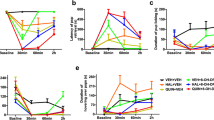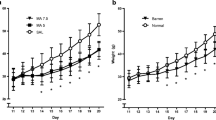Abstract
Primiparous rats received 0.05, 0.25, 0.50, or 1.50 mg d-amphetamine/kg body weight, injected IP, when offspring reached 3–4 and 10–11 days of age. A multidimensional analysis of their maternal behavior revealed that at doses as low as 0.25 mg/kg, amphetamine had a disruptive effect on mother-pup intercontact interval, retrieval latency, inter-retrieval interval, number of pup retrieved and number of corners to which they were retrieved, time nest building, number of paper strips used, nursing time, time in motion, and number of squares entered. Disruption was dose-dependent for all the preceding except number of corners and time nest building. Amphetamine had no effect on the rate of maternal locomotion. The impact of amphetamine on nursing was significantly greater at pup ages of 3–4 days than at 10–11 days. Drug-induced augmentation of arousal exceeding optimal levels for adequate care-giving and locomotor stimulation incompatible with elements of maternal behavior may account for dose-dependent impairment in the range of 0.25 to 1.50 mg/kg d-amphetamine.
Similar content being viewed by others
References
Costa E, Garattini S, eds (1970) International symposium on amphetamines and related compounds. Raven Press, New York
Frańkova S (1977) Drug-induced changes in maternal behavior of rats. Psychopharmacology 53:83–87
Gambill JD, Kornetsky C (1976) Effects of chronic d-amphetamine on social behavior of the rat: Implications for an animal model of paranoid schizophrenia. Psychopharmacology 50:215–223
Glick SD, Muller RU (1971) Paradoxical effects of low doses of d-amphetamine in rats. Psychopharmacologia 22:396–402
Iversen SD, Iversen LL (1975) Behavioral pharmacology. Oxford University Press, New York
Leon M, Croskerry PG, Smith GK (1978) Thermal control of mother-young contact in rats. Physiol Behav 21:793–811
Lu KH, Meites J (1971) Inhibition by l-Dopa and monoamine oxidase inhibitors of prolactin release: Stimulation by methyldopa and d-amphetamine. Proc Soc Exp Biol Med 137:480–483
Meltzer HY, Fessler RG, Simonovic M, Doherty J, Fang CS (1979) Effect of d- and l-amphetamine on rat prolactin levels. Psychopharmacology 61:63–69
Moore KE (1978) Amphetamines: Biochemical and behavioral actions in animals. In: Iversen LL, Iversen SD, Snyder SH (eds) Handbook of psychopharmacology, vol 11. Plenum Press, New York, p 41
Piccirillo M, Cohen DJ, Alpert JE, Shaywitz BA (1980) Effects of 6-hydroxydopamine and amphetamine on rat mothering behavior and offspring development. Pharmacol Biochem Behav (in press)
Piccirillo M, Cohen DJ, Shaywitz BA, Alpert JE, Marinelli D (1979) Maternal care received by rat pups treated with 6-hydroxydopamine. Physiol Behav 22:69–75
Rapoport JL, Buchsbaum MS, Zahn TP, Weingartner J, Ludlow C, Mikkelsen EJ (1978) Dextroamphetamine: Cognitive and behavioral effects in normal prepubertal boys. Science 199:560–563
Rodriguez-Sierra JF, Rosenblatt JS (1977) Does prolactin play a role in estrogen-induced maternal behavior in rats: Apomorphine reduction of prolactin release. Horm Behav 9:1–7
Rosenberg P, Halaris A, Moltz H (1977) Effects of central norepinephrine depletion on the initiation and maintenance of maternal behavior in the rat. Pharmacol Biochem Behav 6:21–24
Schiörring E, Hecht A (1979) Behavioral effects of low, acute doses of d-amphetamine on the dyalic interaction between mother and infant vervet monkeys (Cercopithecus aethiops) during the first six postnatal months. Psychopharmacology 64:219–224
Steele MK, Rowland D, Moltz D (1979) Initiation of maternal behavior in the rat: Possible involvement of limbic norepinephrine. Pharmacol Biochem Behav 11:123–130
Ts'o TOT, Hance AJ, Killam KF (1976) Performance enhancement effects of d-amphetamine, methylphenidate, pipradrol and phenindamine in rats. Psychopharmacologia 46:65–72
Winer BJ (1971) Statistical principles in experimental design. McGraw-Hill, New York
Yehuda S, Frommer R (1978) Effects of d-amphetamine on the set piont of the thermoregulatory in rats. Psychopharmacology 57:249–252
Yehuda, S., Wurtman RJ (1972) Release of brain dopamine as the probable mechanism for the hypothermic effect of d-amphetamine. Nature 240:477–478
Author information
Authors and Affiliations
Rights and permissions
About this article
Cite this article
Piccirillo, M., Alpert, J.E., Cohen, D.J. et al. Amphetamine and maternal behavior: Dose response relationships. Psychopharmacology 70, 195–199 (1980). https://doi.org/10.1007/BF00435314
Received:
Accepted:
Issue Date:
DOI: https://doi.org/10.1007/BF00435314




